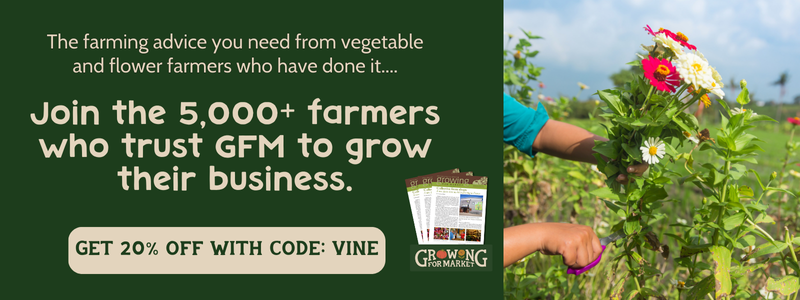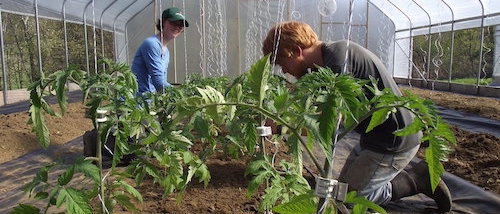There’s nothing worse than doing all the work of buying seeds, sprouting them in the propagation house in expensive potting soil, planting in precious compost rich beds, harvesting into freshly scrubbed buckets, arranging and going to market — and then coming home with unsold bunches. Drying flowers is a great way to preserve all that hard work and prevent throwing gorgeous blooms into the compost pile.
On my farm we grow specialty vegetables and flowers. We treat the flowers with the same love and respect as the veggies: growing a diversity of seasonal varieties, picking at peak, rushing to the cooler or pack shed for processing, and keeping everything über-clean. We move lots of mixed bouquets and straight bunches at our five weekly farmers market stands. But, the reality is there are always leftovers. We know how much value is lost when we have to toss leftovers into the compost pile (if only chickens munched on flowers like they do salad greens).
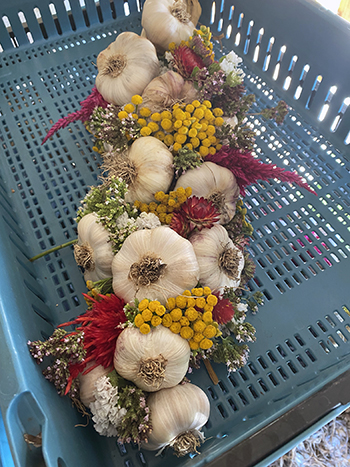 A beautified garlic braid. The trick with the garlic braids is to use fresh flowers while braiding, letting them dry in the braid.
A beautified garlic braid. The trick with the garlic braids is to use fresh flowers while braiding, letting them dry in the braid.
Since we built a dry room on our farm, we have experimented with drying all sorts of flowers and have been amazed by the many varieties that can be dried to preserve the harvest for winter sales. You can be really creative in your dry space, though you may have to get more technical depending on your climate.
When we farmed in the Mediterranean climate of Northern California, for example, we were able to dry flowers in a shed or spare room with no issues. If you live in a dry and arid summer climate, you simply need a space that is as dark as possible with good air flow. In California, we dried flowers in our garage (shed) and an extra storage room in our house. No fan required and flowers dry within days. Sunlight is the main danger in dry climates as it can bleach the color.
Since moving to Upstate New York, we’ve experienced a steep learning curve for how to deal with drying flowers during humid summers. DO NOT try to dry flowers in a humid climate without a dehumidifier — they will mold. In New York, we started with a tiny room under the stairs of our two-story pack shed, hanging wires under the stairs and sticking a dehumidifier in the room. The dark, dry space basically turned into a giant dehydrator and we pumped out an incredible amount of dried flowers by packing the dried ones in boxes to make room for the next rounds.
We graduated to a much bigger dry room in the upstairs of the pack shed, with 14 inches between wires so that we can fit layer upon layer of dried flowers in here. You can maximize space in a dry room by building “shelves” of wires. We go about six lines deep per “shelf,” about 2 inches apart. Since each wire shelf has 14 inches between the string of wires above and below, one wall can hold dozens and dozens of wire lines for hanging.
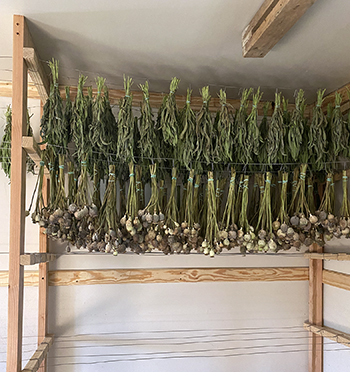 The author’s flower drying setup with wires spaced at the right distance for drying bunches.
The author’s flower drying setup with wires spaced at the right distance for drying bunches.
You can use a basic dehumidifier but will have to dump the water out daily, or you can upgrade to a commercial one that runs continuously with an exit water tube. If you plan to dry a large volume of flowers in a humid climate, the commercial dehumidifier will save you the stress of one more daily chore. And, once you have your dry room set up, you can start to experiment with drying herbs and chiles to bottle up for the winter months, too.
To dry flowers, make sure you strip the leaves just like you would during harvest for fresh cuts. If you don’t strip the leaves, there’s more vegetative matter to dry which could slow down the drying process or allow for the introduction of molds. That being said, I do save some leaves specifically for drying, such as amaranth leaves. Gather stems of like varieties and colors (to save time on the design end later), bundle with a rubber band and cut stems down to fit between your wires. We use paper clips opened up to make hooks. Hook one end through the rubber banded bundle and use the other end to hang on the wire, hanging the flowers upside down. Keep in a dry, dark room and flowers should be dry in around one week, depending on conditions. Once they are fully dry, you can pull the flowers off the line and pack into cardboard boxes to make room for the next round.
Though we do commit some of our flower harvest especially for drying, most of our dried flowers are leftovers from bouquet making or seconds (i.e., bent or crooked stems and market leftovers). Varieties we grow strictly for drying include: nigella, poppy seed heads, flax seed heads, sweet Annie, annual and perennial statice, strawflower, larkspur, and the ‘Nippon Taka’ chiles (though all of these can be used fresh if needed). We also grow sage and thyme for use in our dried flower bouquets and wreaths.
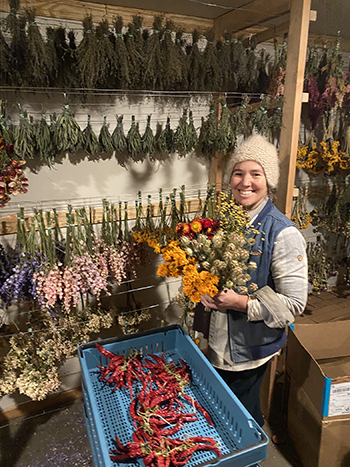 The author with some of the previous season’s dried harvest.
The author with some of the previous season’s dried harvest.
Varieties that we dry as seconds or market leftovers include: zinnia, sunflower, feverfew, daffodils, delphinium, dahlia, ranunculus, peony, marigold, gomphrena, broom corn, grasses and millets, amaranth flowers and leaves, mahogany splendor foliage, celosia, hydrangea, and roses and lavender if you are lucky enough to have them.
You can also glean from cover crops and weeds. I always ask for a small patch of the winter rye to be kept aside for growing to maturity, and we can forage for red dogwood and flowering grasses and orach (a spinach like annual vegetable), if need be.
Varieties that we’ve tried and haven’t had luck with are tulips, ageratum, cosmos, snap dragons, stocks, and bells of Ireland.
You could experiment with a lot of other specialty varieties for drying. Every year I am trying to reduce the insane number of crops I grow, and it really is okay to JUST grow zinnias, sunflowers, marigolds, statice, gomphrena, amaranth, feverfew, larkspur, strawflower, celosia, ‘Nippon Taka’ chilies, sweet Annie, sage, and thyme. Every year I keep leaning in to focus on cut flower varieties that do well in the dry room to get the most value and longevity out of the flowers we are growing.
As I am making bouquets during the warm season, I set aside a crate of seconds as I go. Bent stems or slightly imperfect flowers that don’t make the cut for bouquets get thrown into a crate and then bunched by variety and hung by the crew the next day. I make bouquets late into the night on Friday nights before market weekend. Also, the shorter side branches or lower flowers like in amaranth are kept to hang for drying. It’s amazing what happens to seconds in the dry room. All those bent and broken marigold and zinnia stems straighten right up during the drying process, plus you only need a 2-to-3-inch stem for wreath making.
Once you have a collection of dried flowers, you can wrap them up into bouquets, straight bunches, wreathes, swags, you name it. It’s up to your creative genius at this point. My 10-year-old daughter pulled some gorgeous birch logs covered in mushrooms from our woods, hot glued dried flowers on and sold them at our farmers markets.
I recently bought a clamp machine and, wow, has this revolutionized my wreath making. The key with dried wreaths is to make sure you make even bundles (around 4 to 6 inches) and wrap tightly with wire or use your clamp machine. If you don’t have a clamp machine, I recommend the double wire base.
You can buy many different sized bases, even down to a 6-inch base. The 6-inch base is great for market sales because you can make a small wreath that is not such an overwhelming price for customers. I sell 6-inch base wreaths (they end up being at least 12 inches in diameter) for $45 to $50, which is at least $15 below what I see on sites like Etsy. Customers balk at the price for a minute; in the end, when you create a gorgeous, hand-crafted dried floral product from your farm, your loyal customers will step up for this amazing everlasting arrangement.
When making dried flower wreaths I’ve found that using a base of sweet Annie, thyme, and sage works wonders. Sweet Annie is a highly productive (gets about 8 feet tall in my garden) and fragrant old fashioned dried flower. It has almost a velcro like consistency and is perfect for filling in the wreath base. Weaving in sage, thyme, and chiles (the ‘Taka’ varieties from Kitazawa seeds are awesome for dried flower arrangements) gives the wreaths a fun, culinary feel that links our dried flowers to our veggies and inspires folks to hang the arrangement in their kitchens.
One line of dried flowers I am hoping to experiment with in the future are dried edible flowers. We grow lots of violas for our edible flower line, and they are so fun dried during the off season. I’ve seen granolas, chocolates, pastries, toasts and the like decorated with dried edible flowers during the winter season. My locally blended Earl Grey tea, for example, has dried bachelor button (cornflower) in it.
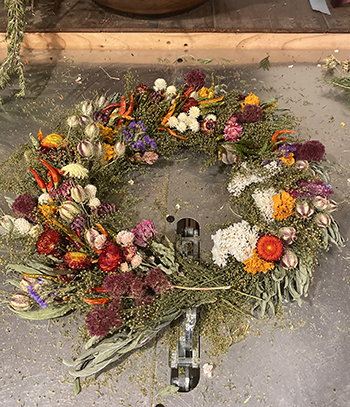 An example of what can be done with dried flowers and a clamp machine.
An example of what can be done with dried flowers and a clamp machine.
Another profitable way to use flowers is to weave them into garlic braids. The only trick with the garlic braids is to use fresh flowers while braiding, letting them dry in the braid. We use them fresh because you need the flower stems to be pliable in order to weave them into the garlic braid. If you try to use already dried flowers in garlic braids, the stems will snap. This was the first year I could find the time to make garlic braids with our ‘Inchelium Red’ softneck crop and we were amazed to see the braids fly off our market tables, even at a $60 price point. I loved using statice, flowering oregano, strawflower, gomphrena, and marigolds in the garlic braids.
As you experiment with dried flowers, remember the labor involved and try to reference your price points to reflect the typical price for everlasting flowers. It’s next to impossible to get an accurate retail price at the farmers markets. Most market shoppers are already budgeting for food purchases, so I’ve found that with flowers you have to find that sweet pricing point where you are making sure to ask enough for the value of your product while offering a competitive price that ensures your products will move.
To start figuring my price point, I look online (Etsy or other dried flower farms) to see what the average prices are. I also look at local and regional farmers markets and specialty grocers to see what dried flowers are going for. I start with a higher pricing point to gauge the market demand and adjust accordingly. With my garlic braids, for example, I started at $65 for braids with 13 heads of garlic and dried flowers weaved in. They were moving slowly, but when I brought the price down to $60 they started to fly. As a general rule, start high with your pricing and then bring it down in small increments until you find the price point that allows your products to sell in volume at the highest price your market can support.
Corinne Hansch is an organic farmer in Upstate New York and mama to three wild and happy homeschooled kids.
